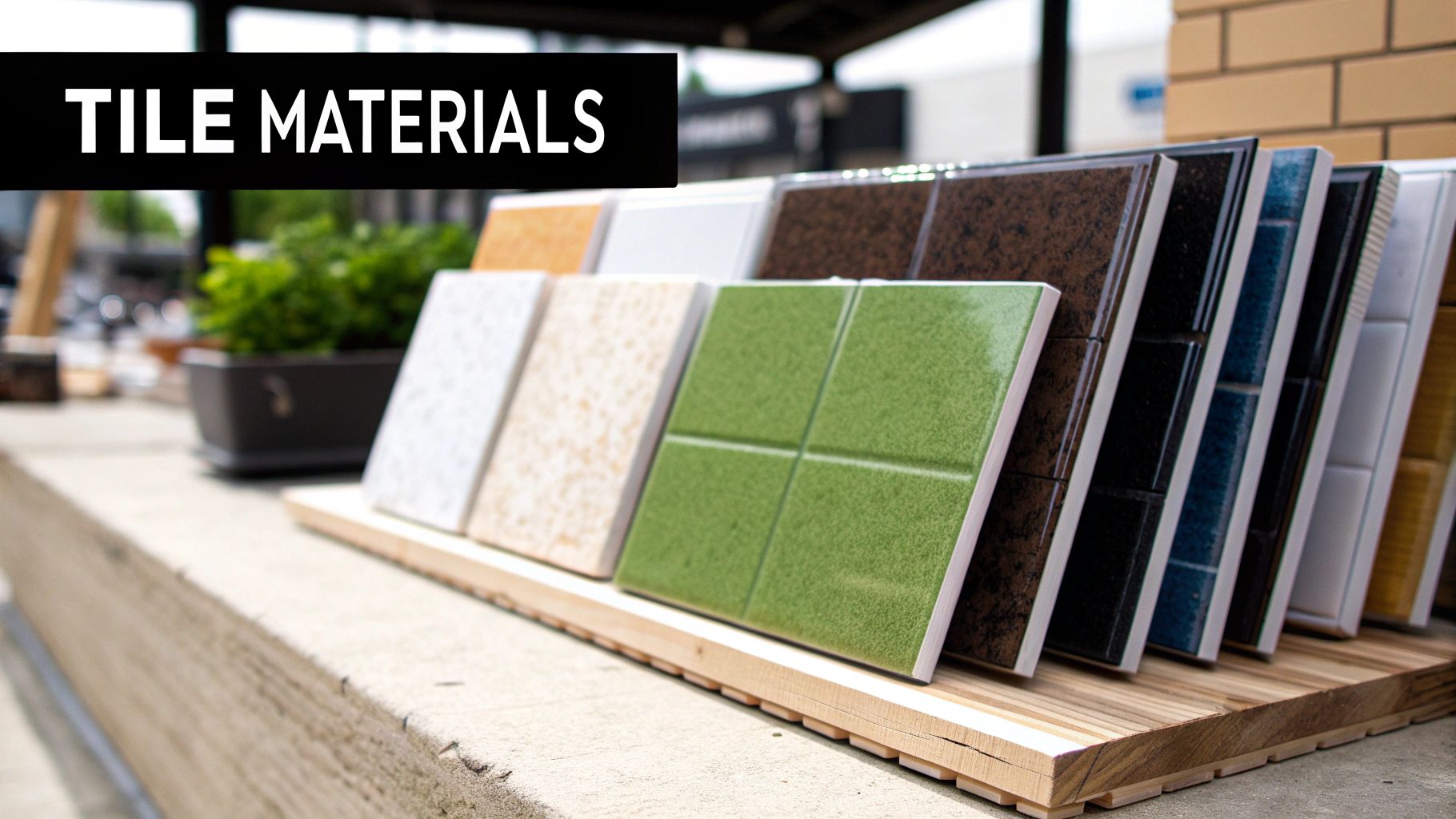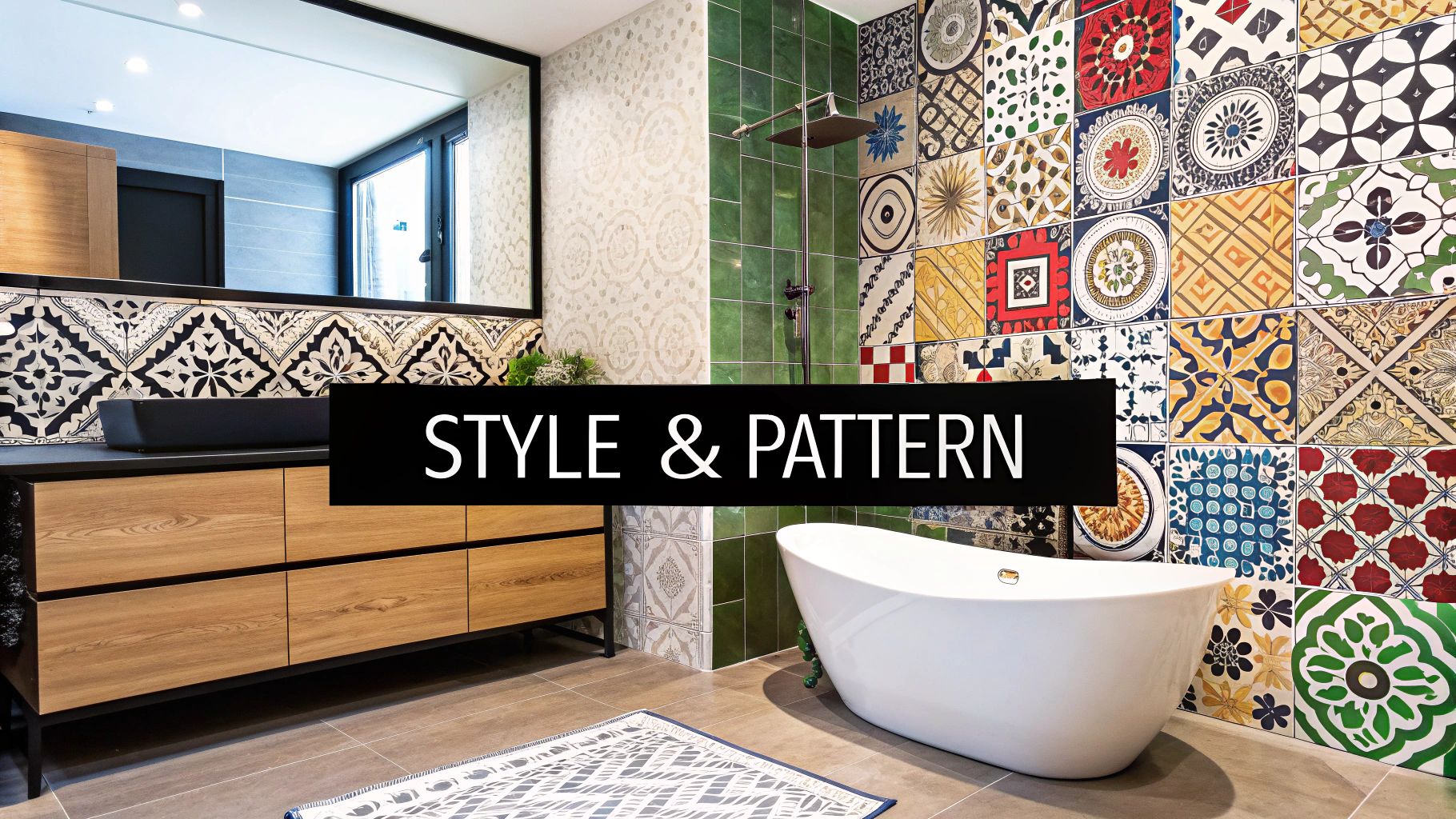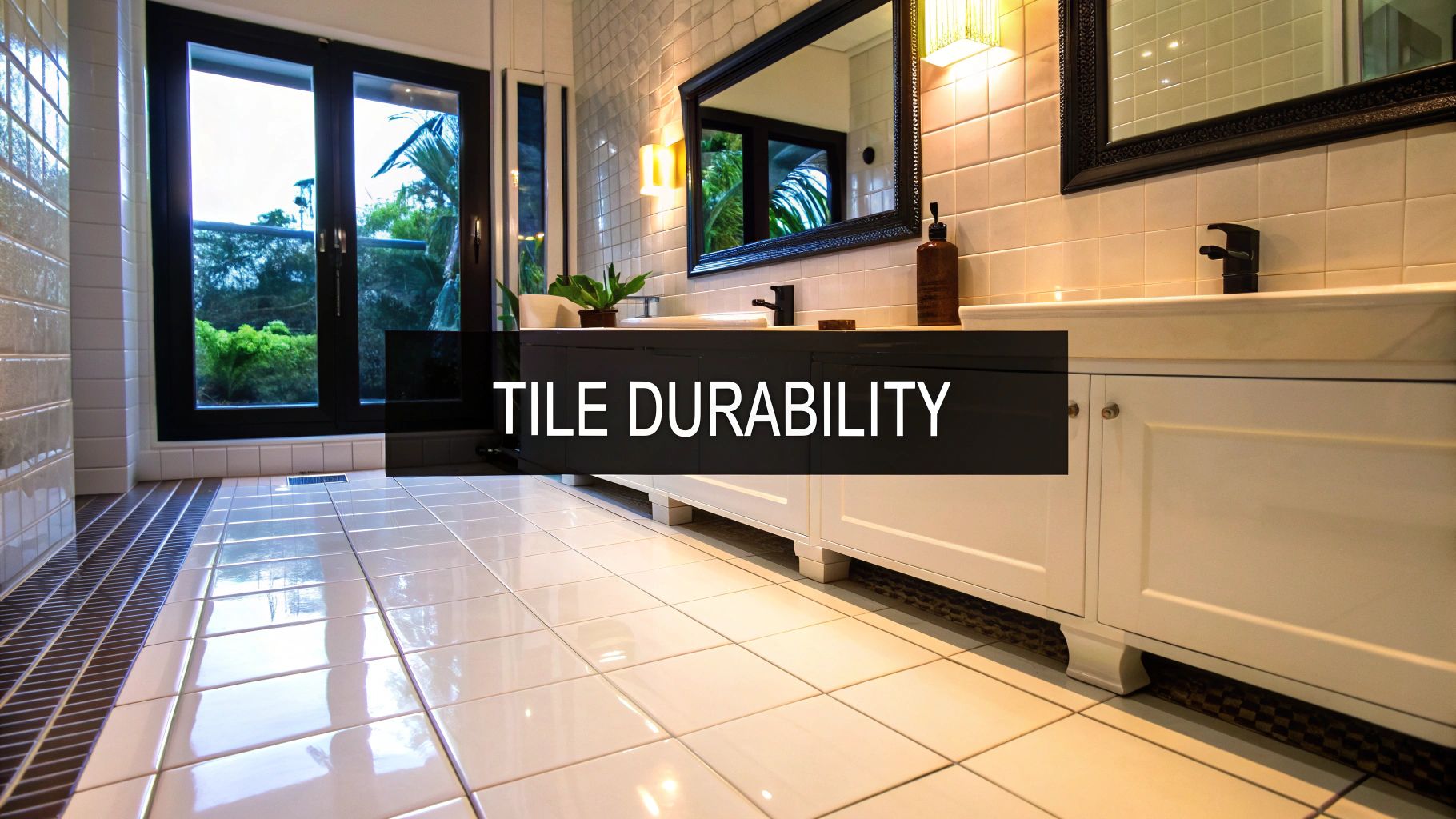Decoding Bathroom Tile Materials: What Professionals Choose

Choosing the right bathroom tiles is a multifaceted decision. It's not just about aesthetics; it's about understanding the inherent properties of different materials. Professionals carefully weigh factors like water resistance, durability, and maintenance before making their selection. Let’s explore some of the most popular tile options available in the UK.
Porcelain: The Leading Choice
Porcelain tiles are a dominant force in UK bathrooms, accounting for over 60% of installations. Their popularity is rooted in their impressive durability and incredibly low water absorption rate, making them perfectly suited for wet environments. Their dense composition resists staining and chipping, ensuring long-lasting beauty even with frequent use. This resilience makes porcelain a sensible and practical choice for busy family bathrooms.
Ceramic: A Cost-Effective Option
Ceramic tiles present a more budget-friendly alternative without sacrificing style. They are incredibly versatile and available in a broad spectrum of colours and designs. However, compared to porcelain, they are slightly less durable and more porous. This means ceramic tiles might require more regular sealing to prevent water damage, particularly in shower areas.
Natural Stone: An Elegant Upgrade
Natural stone tiles, such as marble, travertine, and slate, introduce an element of luxury and unique character to any bathroom. Each tile boasts distinctive veining and textures, resulting in a truly bespoke look. Marble offers timeless elegance, while slate provides a rustic charm. It’s important to note that natural stone requires specialized care and sealing because of its higher porosity.
Glass: A Modern Touch
Glass tiles offer a sleek and modern aesthetic, reflecting light beautifully to make smaller bathrooms appear larger. They are non-porous and highly resistant to stains and mildew. However, glass can be more prone to chipping and cracking than porcelain, so careful installation is vital for longevity.
Understanding Current Trends
Understanding current market trends is key when choosing bathroom tiles. Interestingly, the Midlands region dominates the UK ceramic tile industry, representing over 50% of the market. Within this landscape, porcelain tiles hold the majority share, at over 60%, thanks to their durability and aesthetic appeal. This data clearly shows the importance of quality and style in consumer choices for bathroom renovations. For more detailed statistics, check out the Ceramic Tiles Industry in UK report.
Comparing Tile Materials
To help you navigate the various bathroom tile options, we’ve compiled a comparison table highlighting key properties. This table provides a quick overview of the pros and cons of each material to help you make the best decision for your bathroom project.
Bathroom Tile Materials Comparison: A comprehensive comparison of popular bathroom tile materials highlighting their key properties
| Material | Water Resistance | Durability | Cost Range | Maintenance Level |
|---|---|---|---|---|
| Porcelain | Excellent | High | Mid-High | Low |
| Ceramic | Good | Medium | Low-Mid | Medium |
| Natural Stone | Varies | Medium-High | High | High |
| Glass | Excellent | Medium | Mid-High | Low |
The table summarizes the key differences between popular bathroom tile materials, making it easier to compare their suitability for your specific needs.
Explore our full product catalogue for a wider selection of tiles. Ultimately, the best bathroom tile material depends on your budget, design preferences, and lifestyle. By understanding the characteristics of each option, you can make a well-informed choice that will enhance your bathroom for years to come.
Size Matters: Strategic Tile Dimensions for Visual Impact

Tile size plays a crucial role in how spacious your bathroom appears. It's not just about covering the surfaces; it's about creating a visual illusion of more space. Leading UK designers are strategically employing tile dimensions to make even compact bathrooms feel surprisingly open and airy. Let's explore how you can achieve this in your own bathroom renovation.
Breaking the "Small Tiles for Small Spaces" Myth
The traditional advice of using small tiles in small spaces is being increasingly questioned. While small tiles can add intricate details, they can also make a space feel cluttered. The numerous grout lines can visually shrink a small bathroom. In contrast, large-format tiles create a seamless, expansive appearance, making them a preferred choice for modern UK bathroom designs.
This shift reflects a broader trend in the UK ceramics market, which is expected to hit USD 1.32 billion by 2030. This growth highlights the increasing importance of ceramic tiles in UK bathroom renovations. You can find more detailed statistics from Mordor Intelligence.
The Power of Large-Format Tiles
Large-format tiles minimize grout lines, creating a smoother, uninterrupted surface. This adds to the sense of openness, allowing the eye to move freely across the room. The larger tiles also reflect light more effectively, further enhancing the feeling of spaciousness. This is particularly advantageous in UK bathrooms, where natural light can be limited.
Mixing Tile Formats for Visual Interest
While large-format tiles offer several advantages, incorporating a mix of tile sizes can add depth and personality. Using larger tiles on the floor and smaller tiles as accents on the walls can create a balanced and visually appealing design. This allows you to introduce texture and patterns without overwhelming the space. Consider using smaller mosaic tiles to create a focal point, perhaps a feature wall in the shower or a border around the mirror.
Practical Considerations for Tile Sizing
Selecting the right tile size also involves practical factors. Larger tiles might require more precise cutting and installation, potentially leading to higher labor costs. However, the reduced grouting time can help offset this.
The tile size should be proportional to the bathroom's dimensions. Overly large tiles in a very small bathroom can appear disproportionate. Carefully consider your bathroom's measurements and how different tile sizes will affect the overall visual impact. This will help you choose a tile that balances aesthetics with practicality and ensures a stylish and functional bathroom tailored to your needs and preferences.
Crafting Your Colour Story: Beyond Passing Trends

Choosing the right colour palette is crucial for setting the tone and atmosphere of your bathroom. While it's tempting to follow the latest trends, a timeless colour story will ensure lasting style. This means prioritizing colours and combinations that endure beyond fleeting fads. This section will guide you in crafting a colour scheme that reflects your individual style and maintains enduring appeal.
Understanding the Psychology of Colour
Colour has a profound impact on our mood and perception, particularly in a space like the bathroom. This room is designed for relaxation and rejuvenation, so colour choices are key. Cool blues and greens, for instance, evoke tranquility, mimicking the serenity of nature. These hues are popular in UK bathrooms, creating a spa-like atmosphere.
Warm tones like yellows and oranges, on the other hand, offer energy and vibrancy. Neutrals like white and grey provide a clean, classic foundation. Considering the psychological impact of colour can help you create the desired mood in your bathroom.
Creating Visual Harmony: Complementary and Contrasting Schemes
A harmonious colour scheme relies on understanding colour relationships. Complementary colours, opposite each other on the colour wheel (like blue and orange), create dynamic contrast. Analogous colours, adjacent on the wheel (like blue and green), offer a subtle, harmonious blend.
Using various shades and tints of the same colour creates a monochromatic look. This approach is visually calming and offers a sophisticated simplicity. Experimenting with these colour relationships can help you achieve the perfect balance.
Incorporating Patterns and Textures
Statement patterns can inject personality into your bathroom. However, it's important to avoid overwhelming the space. Balance bold patterned tiles with simpler, solid-coloured tiles to prevent a cluttered feel. You might find this article helpful: How to master balancing your bathroom tiles.
Textured tiles add depth and visual interest without relying solely on colour. This allows you to create a layered and dynamic look, enhancing the overall design.
The Importance of Grout Colour
Grout colour, often an afterthought, significantly impacts the overall aesthetic. Contrasting grout emphasizes tile shape and creates a dramatic look. For example, dark grout with light tiles creates a striking grid.
Matching grout to the tiles creates a seamless, understated look. This choice emphasizes the tiles themselves and minimizes visual breaks. Consider both options to achieve your desired effect.
Balancing Personal Expression With Timeless Design
Ultimately, your bathroom should reflect your style. However, consider the longevity of your colour choices. While trendy colours might be tempting, a classic palette stands the test of time. This doesn't mean sacrificing personal expression.
Incorporate trendy colours as accents through accessories and towels. These are easy to update as styles change. This approach allows personalisation while ensuring a stylish bathroom for years to come.
The Safety-Style Balance: Practical Choices That Protect

When selecting bathroom tiles, safety should be a key consideration alongside style. A beautiful bathroom is only truly enjoyable when it also provides a safe environment, especially in damp climates where surfaces can become slippery. This requires thinking beyond aesthetics and focusing on practical, protective choices for your family.
Understanding Slip Resistance
One crucial safety aspect is slip resistance, measured by the Pendulum Test Value (PTV). A higher PTV indicates better grip. For wet, barefoot areas like shower floors, a PTV of 36 or higher is recommended.
Textured tiles or those with a matte finish offer superior grip compared to smooth, polished surfaces. This added texture ensures secure footing, minimizing fall risks, particularly for children and older adults. Carefully evaluating slip resistance is vital for a safe and functional bathroom.
Mould and Mildew Resistance
Humid climates make bathrooms susceptible to mould and mildew, which are not only unsightly but also potential health hazards. Opt for tile materials inherently resistant to mould growth, like porcelain tiles with their low porosity.
Even with mould-resistant tiles, adequate ventilation and regular cleaning are essential. Ensure good airflow in your bathroom and wipe down surfaces after each use to prevent mould and mildew.
Maintenance and Cleaning
Long-term maintenance is another important factor. Some tile materials are more prone to staining or scratching from certain cleaning products. Abrasive cleaners, for example, can damage natural stone.
For easy cleaning, choose durable materials like porcelain or ceramic tiles. These withstand regular cleaning without losing their shine. Durability and ease of cleaning are increasingly important factors for consumers when choosing tiles. Learn more about the UK tile market trends.
Ageing-in-Place Considerations
For future-proof bathroom renovations, consider ageing-in-place design principles. These focus on accessibility and safety for all ages and abilities.
This might include incorporating grab bars, non-slip flooring, and walk-in showers. Larger format tiles minimize grout lines and enhance safety and practicality, contributing to an accessible bathroom.
Balancing Safety and Style
Prioritizing safety doesn't mean compromising on style. Many tile manufacturers offer stylish options with enhanced safety features. You can achieve a bathroom that's both beautiful and safe.
For instance, some manufacturers offer textured tiles that mimic natural stone, combining slip resistance with aesthetic appeal. This allows you to prioritize safety without sacrificing your design vision. By carefully considering these factors, you can create a bathroom that is both beautiful and safe.
Smart Budgeting: Where to Invest and Where to Save
Creating a realistic budget for bathroom tiles is essential for a successful UK renovation. It's not about simply finding the cheapest tiles. Instead, focus on understanding where to prioritize your spending and where to save without sacrificing quality. This smart approach helps you design a stylish and functional bathroom that aligns with your financial goals.
Identifying Key Investment Areas
Some aspects of your tiling project warrant a higher investment. Prioritizing these key areas ensures longevity and reduces future costs.
-
Floor Tiles: Bathroom floors endure heavy foot traffic and constant moisture. Investing in durable, high-quality floor tiles, such as porcelain, withstands this wear and tear. This upfront cost saves you money long term by reducing the need for replacements.
-
Shower Area Tiles: Constantly exposed to water, this area demands tiles with superior water resistance. Opt for premium tiles designed for wet conditions, like porcelain or specially treated ceramic. This protects against moisture damage and extends the life of your shower.
-
Feature Wall Tiles: A feature wall is your opportunity to add a touch of luxury. Invest in tiles that make a statement, whether through unique designs or premium materials. This focal point elevates your bathroom's overall design.
Finding Smart Savings
While certain areas require investment, others offer opportunities to save.
-
Wall Tiles Outside Wet Areas: Areas less exposed to water, like walls outside the shower, can utilize more budget-friendly options. Ceramic tiles offer an excellent balance of affordability and style.
-
Sale and Clearance Items: Look for sales, clearance items, and discontinued lines. You can often find high-quality tiles at significantly reduced prices. Timing your purchase strategically can result in substantial savings. Check out our guide on How to master your bathroom tile budget for more tips.
-
Mixing Tile Types: Combine premium and budget-friendly tiles for a balanced look. For instance, use high-quality porcelain tiles on the shower floor and more affordable ceramic tiles on the adjacent walls. This maximizes impact while minimizing cost.
Calculating Tile Quantities and Costs
Precisely calculating the required number of tiles prevents overspending and material shortages. Measure the area to be tiled in square meters. Include a 10-15% wastage allowance for cuts and breakage, a standard practice in the UK.
Purchase a few extra tiles from the same batch for future repairs. Batch consistency is important because slight variations in colour and shade can occur between production runs. Having extra tiles on hand ensures a perfect match for any future repairs.
Evaluating Quality Indicators
Don't solely rely on price to determine quality. Consider the tile's PEI rating (Porcelain Enamel Institute), which measures wear resistance. A higher PEI rating means greater durability. Also, check the tile's water absorption rate, especially for wet areas. Lower absorption translates to better water resistance.
By strategically investing, finding smart savings, and understanding quality indicators, you can create a beautiful and functional bathroom without exceeding your budget.
Navigating the UK Tile Marketplace: Finding Hidden Gems
Choosing the right bathroom tiles can be a daunting task. It's not just about picking a color and size; it's about understanding the UK tile market and finding the best retailer for your needs. From small, local showrooms to national chains and online marketplaces, the sheer number of options can be overwhelming. This guide will help you understand the various purchasing routes available and empower you to find the perfect tiles for your project.
Understanding the UK Tile Retail Landscape
The UK tile market offers a diverse range of purchasing options, each with its own set of advantages. Independent tile showrooms provide personalised service and expert guidance, often showcasing unique and exclusive designs. Large DIY chains like B&Q and Wickes offer a wider selection of budget-friendly tiles, but may lack specialised product knowledge. Online marketplaces, such as Tile Giant, offer convenience and extensive choice, but it can be difficult to assess tile quality without seeing them in person. Understanding these distinct channels is key to making an informed decision based on factors like availability, desired quality, and budget. The increasing popularity of online shopping provides additional choices and purchasing convenience. For further insights into the tile market, you can explore this research report.
To help illustrate the differences, let's take a look at the following comparison:
To help compare different retailer types, we've compiled a table summarising the key advantages of each:
UK Bathroom Tile Retailers Comparison: An overview of different types of tile retailers in the UK market with their respective advantages.
| Retailer Type | Product Range | Price Point | Expert Advice | Sample Availability |
|---|---|---|---|---|
| Independent Tile Showrooms | Specialised, unique designs | Mid-range to high-end | Personalised, in-depth | Usually available |
| Large DIY Chains | Wide, budget-friendly options | Value-driven, competitive | Limited, general advice | Often available |
| Online Marketplaces | Extensive, varied selection | Competitive, often discounted | Online resources, customer reviews | Varies, digital samples may be available |
As you can see, each retailer type offers distinct benefits. Considering your individual needs and priorities will guide you towards the right choice.
Evaluating Tile Quality and Negotiating Prices
No matter where you purchase your tiles, assessing quality is crucial. Carefully examine the tile surface for evenness and consistency. Look for any chips, cracks, or glazing imperfections. Gently tap the tile; a resonant, ringing sound indicates good quality. Ask about the tile’s PEI rating (Porcelain Enamel Institute rating) and water absorption rate, both key indicators of quality and durability. A higher PEI rating signifies better resistance to scratches and wear, while a lower absorption rate is essential for wet areas like bathrooms.
Don't be afraid to negotiate prices, especially for larger orders. Many retailers, especially independent showrooms, are open to offering discounts. Look for manufacturers that produce high-quality tiles at mid-range prices. These companies often prioritise quality over extensive marketing campaigns, providing excellent value for your money.
Key Questions and Emerging Technologies
Before finalising your purchase, inquire about stock availability, particularly if you have a large project. Confirm batch consistency to ensure all tiles match perfectly in color and shade. Understand the returns policy in case of damage or incorrect orders. These proactive measures will safeguard you against potential problems during your project.
Technology is transforming the tile selection process. Many retailers now offer digital visualization tools and online sampling. This allows you to see how tiles will look in your bathroom before you buy, giving you the confidence to make the right choices.
Building Relationships for Long-Term Success
For larger renovations or ongoing projects, cultivating a relationship with your tile supplier can be invaluable. A reliable supplier can offer expert advice, keep you updated on new products, and assist with any issues that arise. This ongoing support can significantly simplify your renovation and ensure a smooth, successful outcome.
Article created using Outrank


Share:
Premium Tiles for a Dream Kitchen
Victorian Bathroom Floor Tiles — Timeless & Elegant Design